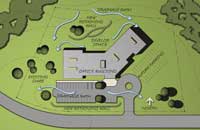Managing Water on the Jobsite
The design and performance of most retaining walls are based on keeping the reinforced zone relatively dry. To ensure that retaining wall structures perform, the construction of the retaining wall and layout of the site must be based on maintaining a soil moisture content that is relatively low. Relatively low equates to the moisture content required to achieve desired compaction.
Site civil engineering firms utilize a thorough understanding of the site to determine where water will come from and how it will be properly managed. Throughout their design process, sources of water are taken into account to handle above and below grade concentrations of water.
Contractors must understand the intent of the approved site plans and what will be required to protect the area impacted by the wall construction. Temporary berms may be required to direct water away from construction sites.
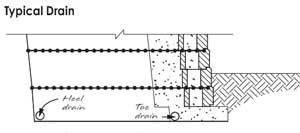
Drains must be vented to daylight or connected to a storm sewer system.
All drain pipes must be protected from migration of fine material. Refer to approved plans for construction details.
Allan Block walls may be designed with an array of details to ensure that the retaining wall and reinforced soil structure remain free of excess moisture. Basic design details mandate toe drains for all walls over 4 ft. (1.2 m) in height, with slopes, or other structures above the wall. Once geogrid is introduced into the design, heel drains are also incorporated. In all cases wall rock is located within the cores of the block and a minimum of 12 in. (300 mm) behind the block. These three details are designed to remove incidental water within their respective locations and are not meant as primary drainage paths for above or below grade water management. Refer to your approved plans or the AB Spec Book for specific information on these items.
Grading
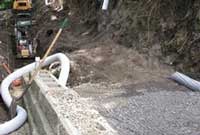
Retaining wall with drain
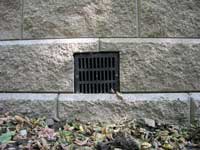
Retaining wall with drain vent
Download cross section drawing
During retaining wall layout it is important to evaluate the entire site to determine if water will drain into the area where the walls will be constructed. Using simple berms and swales to divert the water around the retaining wall can be easily done. Since walls are often built before the site is completely graded to its final configuration, temporary grading must be in place to ensure water will not be draining towards the construction area. Contact the local engineer of record and the site civil engineer for directions prior to proceeding with construction of the retaining wall.
Ground Water
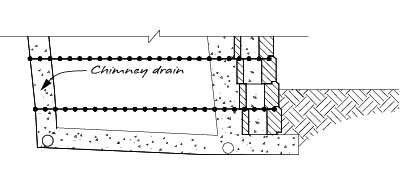
Chimney Drain
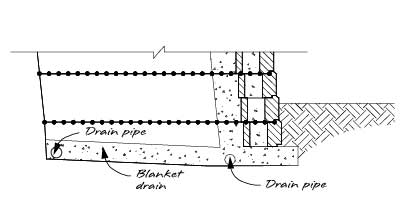
Blanket Drain
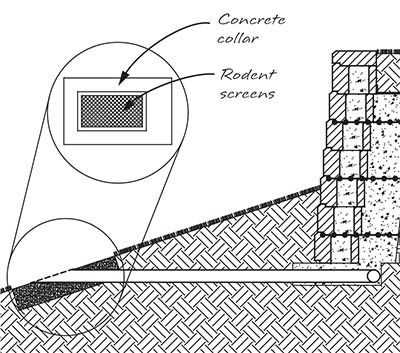
Vent Drain with Pipe Option
Ground water can be defined as water that occurs within the soil. Sources include surface infiltration, water table fluctuation and layers of permeable soils. Ground water movement must be prevented from coming in contact with the retaining wall structure, including the reinforced soil mass.
Construction details to prevent subsurface water from coming in contact with the retaining wall structure should be defined on the approved plans. Use blanket and chimney drains to intercept ground water from potentially infiltrating the reinforced mass. When ground water is encountered during construction work with the engineer of record to ensure that the water has been accounted for in the design.
Extra care must be employed to prevent water from entering the reinforced zone when non-permeable infill soils are used in wall construction.
Drain pipes used in toe or heel drain applications must be properly vented a minimum of every 50 ft (15 m). Methods to accomplish this include having drain pipes draining into the storm sewer system or vented to a lower elevation on the site. See approved plans for locations.
When venting to a lower elevation, it is important that all drain locations are properly marked during the construction phase and protected during and after the completion of the project to ensure that the drain pipe is not damaged or plugged. Rodent screens and concrete collars are examples of details employed to allow for water to flow through the outlet pipes and keep the pathway clear of debris. If details are not identified on the plans, request guidance from the local engineer or the site civil engineer.
Concentrated Water Sources
Prior to constructing the retaining wall, review drainage plans and details with the general contractor or site civil engineer to identify all potential sources of concentrated water.
Examples that must be accounted for are:
- Below grade storm sewer pipes
- Water lines, mains or fire hydrants
- Grading of site
- Parking lots
- Catch basin to storm sewer system
- Roof down spouts
- Slopes above walls


